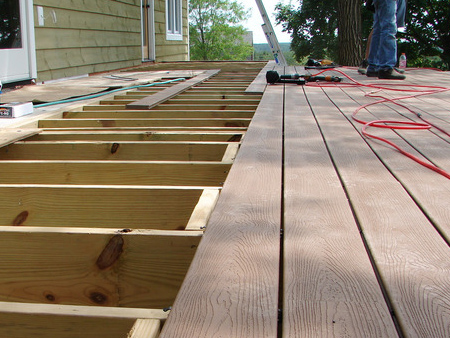Deck Installation
 Things to Keep in Mind
Things to Keep in Mind
Boards, like most materials, will expand when hot and contract when cold. So for butt end spacing, be certain to follow the manufacturer’s recommendations for spacing to the letter.
Board edges spaced too close together will invite clogging of materials, which will contribute to pooling of water, which in turn will cause staining and the premature disintegration of the boards. You can use a 16d nail to calibrate the proper spacing between boards and avoid the aforementioned hazards.
Keep your joists spaced no more than 16 inches on center. Otherwise, composites will sag.
If you place screws too close to an edge, composites can crumble, so keep your screws at least ¾ of an inch from edges and ends of boards.
Decking Materials - Wood
this is the choice of many who want a natural looking deck. It is structurally strong and will retain its beauty as long as it is cleaned every year and restained every two or three years. Negatives: under certain conditions, it can warp or even rot.
Pressure Treated Wood: this wood, which is impregnated under pressure with chemicals to reduce the tendency to rot and to keep obnoxious insects out, can last a long time, perhaps fifteen years or even longer. Negatives: Always wear gloves and a mask when you work with pressure treated wood because it contains poisons that will cause severe health problems or even death if absorbed through the skin or inhaled.
Never burn pressure treated wood because the poisons in the wood will be carried in the smoke and can cause great harm to your health.
Also, use only stainless steel fasteners, because the chemicals in the wood tend to be corrosive.